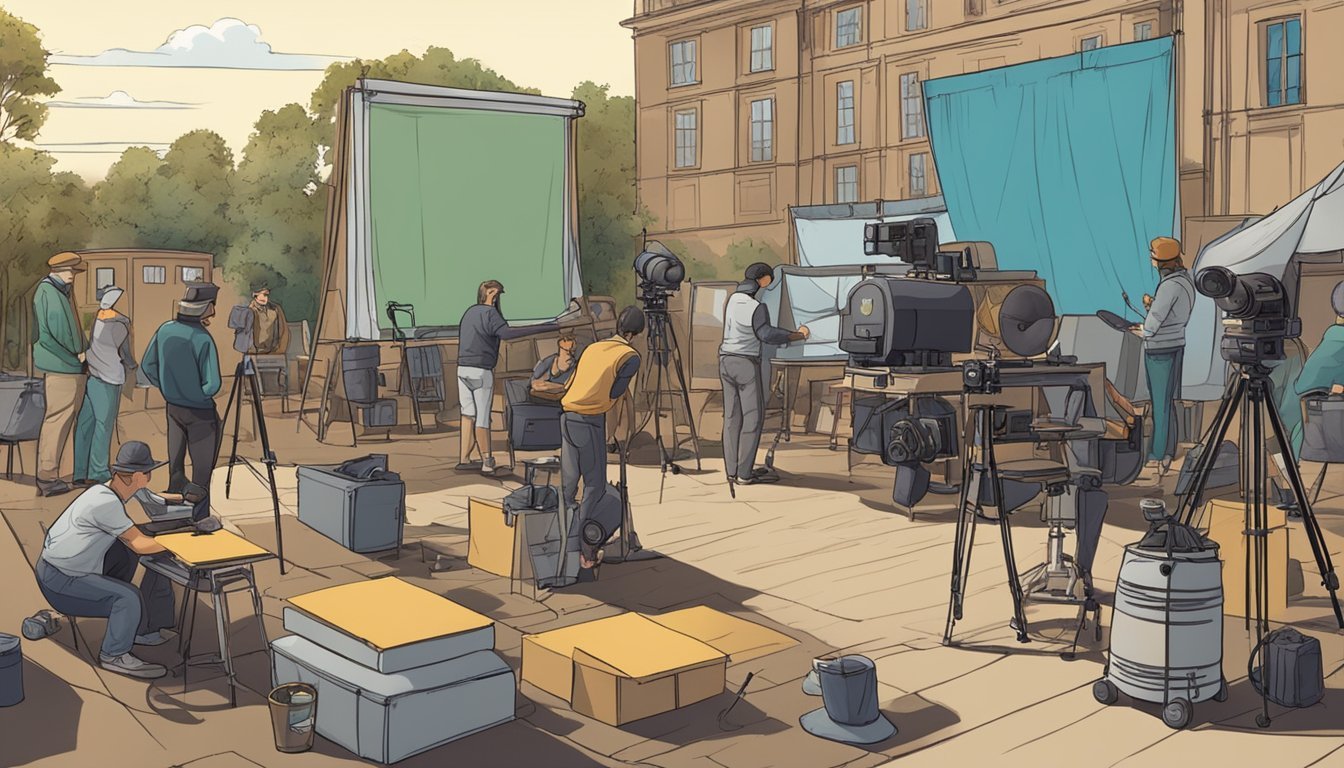JonBenét's Killer Exposed? Star-Studded Cast Unveils Shocking New Evidence in Gripping Netflix Drama
The unsolved murder of JonBenét Ramsey has captivated the public for decades, spawning numerous film and TV adaptations. Several productions have tackled this tragic case, each with its own cast portraying the key figures involved. Notable actors who have taken on roles in JonBenét Ramsey projects include Melissa McCarthy, Clive Owen, and Alison Pill in an upcoming Paramount+ limited series.
Previous adaptations have featured actors like Eion Bailey, Julia Campbell, and Michel Gill in the 2016 Lifetime movie "Who Killed JonBenét?" Kiefer O'Reilly portrayed Burke Ramsey, JonBenét's brother, in this production. The case continues to intrigue filmmakers and audiences alike, with each new project offering a fresh perspective on the events surrounding the 6-year-old beauty queen's death in 1996.
These dramatizations aim to explore the Ramsey family's life before and after the murder, examining their grief and the intense public scrutiny they faced. While the crime remains unsolved, these productions keep the story alive in popular culture, prompting ongoing discussions about this enduring mystery.
Background on the JonBenét Ramsey Case
The JonBenét Ramsey case remains one of the most infamous unsolved murders in American history. It captivated the nation and sparked intense media coverage and public speculation.
The Ramsey Family and the Tragic Event
JonBenét Ramsey, a 6-year-old beauty pageant contestant, was found dead in her family's Boulder, Colorado home on December 26, 1996. Her parents, John and Patsy Ramsey, reported her missing earlier that day after discovering a ransom note.
The child's body was later found in the basement. She had been strangled and suffered a skull fracture. The Ramsey family, including JonBenét's older brother Burke, immediately fell under suspicion.
Investigators faced challenges due to contamination of the crime scene. The case quickly became complex, with conflicting evidence and theories emerging.
Media Frenzy and Public Scrutiny
The murder of JonBenét Ramsey ignited a media firestorm. News outlets provided round-the-clock coverage, dissecting every detail of the case and the Ramsey family's lives.
Public opinion was divided, with many speculating about the family's involvement. The Ramseys appeared on television to proclaim their innocence, further fueling media attention.
Tabloids published sensational stories, and armchair detectives emerged nationwide. The case became a cultural phenomenon, inspiring books, documentaries, and TV specials.
The intense scrutiny placed immense pressure on the investigation and the Ramsey family. It raised questions about media ethics and the public's fascination with true crime.
Investigation and Key Figures
The JonBenét Ramsey case involved complex investigative efforts and numerous key figures over the years. Multiple law enforcement agencies and private investigators pursued leads and examined evidence in attempts to solve the high-profile homicide.
Initial Investigation and Evidence
Detective Linda Arndt was the first detective to arrive at the Ramsey home on December 26, 1996. She faced criticism for her handling of the crime scene. The ransom note, found by Patsy Ramsey, became a crucial piece of evidence. It was unusually long for a kidnapping note and written on paper from the Ramsey home.
Key physical evidence included:
A broken basement window
DNA traces on JonBenét's clothing
The garrote used in the murder
Investigators also focused on the pineapple found in JonBenét's digestive tract, which didn't match her family's account of her last meal.
Major Investigators and Officials
Detective Steve Thomas led the Boulder Police Department's investigation initially. He believed Patsy Ramsey was responsible for JonBenét's death. Thomas resigned in 1998, criticizing the district attorney's office for their handling of the case.
Lou Smit, a veteran homicide detective, joined the investigation in 1997. He developed the intruder theory, challenging the family-member culprit hypothesis. Smit identified potential DNA evidence supporting his theory.
The case remains one of America's most infamous unsolved murders. Multiple prosecutors and police chiefs have overseen the investigation since 1996, with periodic case reviews and new DNA testing attempts.
Film Production Overview
The JonBenét Ramsey movie brought together a talented creative team and carefully selected cast to portray this sensitive true crime story. Key decisions around directing, cinematography, and casting shaped the film's investigative approach and documentary-style elements.
Creative Team Behind the Movie
Jason Lapeyre directed the film, bringing his experience with true crime stories to the project. The production design by Jill Scott helped recreate the 1990s Colorado setting authentically. Mark Boyko handled set decoration, paying close attention to period-appropriate details.
While not confirmed, it's likely an experienced director of photography was brought on board to capture the film's documentary-style visuals. The creative choices aimed to strike a balance between dramatization and factual presentation of the case.
Casting Choices for Key Roles
Eion Bailey took on the role of Detective Steve Thomas, one of the lead investigators. Michel Gill and Julia Campbell portrayed John and Patsy Ramsey, JonBenét's parents. Young actress Payton Lepinski was cast as JonBenét Ramsey herself.
Curtis Lum appeared as a forgery expert, highlighting the film's focus on investigative elements. The casting prioritized actors who could handle the emotional weight of the story while maintaining a neutral tone.
Additional roles went to performers who could convincingly portray real-life figures involved in the case. The ensemble cast worked to bring nuance to this complex and controversial true crime narrative.
Cast and Crew
The JonBenét Ramsey miniseries features a star-studded ensemble bringing the tragic story to life. Acclaimed actors take on key roles, supported by talented performers in supporting parts.
Lead Cast Portrayals
Melissa McCarthy headlines the cast in a dramatic turn as Patsy Ramsey, JonBenét's mother. Clive Owen portrays John Ramsey, JonBenét's father, bringing gravitas to the role. Garrett Hedlund joins the cast in a significant part, though his specific character remains undisclosed.
Alison Pill takes on a pivotal role, likely as a detective or family friend. Young actress Emily Mitchell has been cast to play JonBenét Ramsey herself, bringing the ill-fated child beauty queen to the screen.
Supporting Cast Insights
Shea Whigham and Will Patton lend their considerable talents to the production in supporting roles. Their characters may include law enforcement officials or family associates caught up in the investigation.
Owen Teague rounds out the announced cast, potentially playing Burke Ramsey, JonBenét's older brother. The supporting ensemble promises to flesh out the complex web of relationships surrounding the case.
Behind the scenes, the miniseries boasts a creative team including Richard LaGravenese, Harrison Query, and Tommy Wallach as writers and creators.
Cinematic Representation
The JonBenét Ramsey case has inspired various film adaptations, each offering a unique perspective on the tragic events. These productions have grappled with the challenge of portraying such a sensitive and complex story on screen.
Adaptation and Script Development
Harrison Query and Tommy Wallach collaborated on a script that aimed to bring nuance to the JonBenét Ramsey story. Their approach focused on exploring the impact of the case on the Boulder community rather than sensationalizing the crime itself. The writers conducted extensive research, interviewing locals and reviewing case files to ensure accuracy.
The script development process involved careful consideration of how to portray key figures, including the Ramsey family, without making unsubstantiated claims. Dialogue was crafted to reflect the tension and uncertainty surrounding the case, allowing viewers to draw their own conclusions.
Filming Locations and Setting
Calgary served as a stand-in for Boulder, Colorado in one notable production. The Canadian city's architecture and natural surroundings provided a convincing backdrop for recreating the Ramsey home and neighborhood. Producers chose specific locations that mirrored Boulder's affluent suburban atmosphere of the mid-1990s.
Set designers meticulously recreated the Ramsey house interior based on crime scene photos and public records. This attention to detail helped actors immerse themselves in the roles and added authenticity to the production. Exterior shots captured the contrast between the picturesque mountain setting and the dark events that unfolded within.
Distribution and Reception
The JonBenét Ramsey movie garnered attention across various platforms, eliciting mixed reactions from viewers and critics alike. Its distribution strategy and public response shaped its impact on audiences.
Release Platforms and Accessibility
The JonBenét Ramsey film debuted on traditional cable networks, reaching a wide television audience. It later became available on streaming services like Paramount+ and Netflix, expanding its accessibility.
MTV Entertainment Studios played a role in distributing the movie to younger demographics. The film's availability on multiple platforms increased its potential viewership.
Documentaries related to the JonBenét Ramsey case also found homes on these streaming services, often complementing the fictional dramatization.
Audience and Critical Reaction
Viewers expressed divided opinions on the film's portrayal of the tragic events. Some praised the performances and storytelling, while others criticized its approach to the sensitive subject matter.
Critics scrutinized the movie's accuracy and ethical considerations in dramatizing a real-life tragedy. Reviews highlighted both the compelling aspects of the production and concerns about potential sensationalism.
The film sparked renewed public interest in the unsolved case, leading to discussions on true crime entertainment ethics. Its reception varied between those seeking factual information and those drawn to the dramatic retelling.
Legal Considerations and Ethical Issues
Producing a movie about JonBenét Ramsey's case involves complex legal and ethical challenges. Filmmakers must navigate privacy concerns, liability risks, and the responsibility of portraying real people and events accurately.
Privacy Considerations in True Crime Adaptations
True crime adaptations like a JonBenét Ramsey movie must respect the privacy of individuals involved in the case. Filmmakers should obtain proper permissions and releases from living persons depicted in the film. They must also be cautious about revealing sensitive information that could violate privacy laws or cause emotional distress to the Ramsey family and others connected to the case.
Producers should consult legal experts to ensure compliance with privacy regulations. This includes carefully vetting scripts and fact-checking to avoid potential defamation claims. Balancing public interest with individual privacy rights is crucial in true crime adaptations.
Terms of Use and Depiction of Real Events
Movie producers must adhere to strict terms of use when adapting real events for the screen. This includes obtaining rights to use case materials, police reports, and media coverage. Filmmakers should clearly state that their work is a dramatization based on true events, not a documentary.
Accurate portrayal of key facts is essential to avoid legal issues. However, creative liberties may be taken with dialogue and minor details. Producers should include disclaimers about fictionalized elements and consult with legal teams to ensure compliance with terms of use for any copyrighted materials or archival footage used in the film.
Cultural Impact
The JonBenét Ramsey case has left an indelible mark on American popular culture. Its influence extends beyond true crime circles, captivating the public imagination for decades.
Influence on True Crime Genre
The JonBenét Ramsey case significantly shaped the true crime genre. Numerous documentaries, books, and podcasts have explored the unsolved murder, setting a template for in-depth examinations of complex cases. These productions often feature interviews with key figures, reenactments, and analysis of evidence.
The case's enduring mystery has inspired filmmakers to experiment with unconventional storytelling techniques. For example, the Netflix documentary "Casting JonBenet" took a unique approach by focusing on the auditioning process for a fictional film about the case, revealing how the public perceives and interprets the tragedy.
Ongoing Public Fascination
The JonBenét Ramsey case continues to captivate audiences nearly three decades after the event. Regular media coverage, anniversary specials, and new investigative efforts keep the case in the public eye. The tragedy has become a cultural touchstone, often referenced in discussions about unsolved crimes and child safety.
The case has also influenced fictional narratives. While not directly related, shows like "My Life with the Walter Boys" touch on themes of family tragedy and public scrutiny, echoing elements of the Ramsey case's impact on American consciousness.
Social media has fueled ongoing discussions, with amateur sleuths sharing theories and analyzing evidence online. This sustained interest demonstrates the case's lasting impact on public discourse around crime, justice, and media representation.








